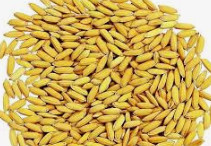Effects of Two Temperatures and Two Drying Ways on Rice Quality
The rice was treated by microwave and hot air drying at low temperature (45 ~C) and high temperature (65 ~C) at constant temperature. Compared with the natural air drying control group, the changes of germination rate, iodine blue value, soluble protein content, amylose content (including solubility and insolubility) and gelatinization characteristics were studied.
The results showed that at low temperature, the iodine blue value, soluble protein content and soluble amylose content of paddy were increased, while the insoluble amylose content was decreased, compared with the natural air-drying control group, the microwave drying equipment and hot air drying treatment showed lower minimum viscosity, larger breakage value and lower final viscosity in gelatinization properties, thus improving the quality of paddy.
Moreover, low temperature microwave drying at constant temperature can shorten the drying time, improve the drying efficiency of paddy, and improve the effect of temperature fluctuation of conventional microwave drying on the quality of paddy. Compared with natural air drying control group, microwave and hot air drying treatment at high temperature damaged the quality of paddy, which was not conducive to later storage and consumption.
Key words: rice microwave drying; hot air drying; quality


The moisture content of rice after harvest is usually high, and it is easy to grow insects, fever and mildew during storage. Drying is an important process after harvesting of rice, but rice is a grain with high thermal sensitivity. Unreasonable drying conditions will change the physical and chemical characteristics of the main components of rice. In order to protect the taste quality of rice during drying and to consider the economic benefits, different drying methods and drying processes need to be studied.
As a new energy-saving drying method, microwave drying has been applied to grain. However, the measurement and control of temperature during microwave drying are not mature enough. The grain temperature rises rapidly, and the quality of the dried grain will fluctuate greatly, even the phenomenon of internal scorch will occur. In order to realize microwave constant temperature drying, the real-time temperature of grain should be measured and the working state of microwave should be controlled.
The main parameters affecting the drying quality of paddy should be the temperature of paddy itself, not the temperature of hot air. Wei Chengli et al. determined the initial temperature and limit temperature of drying medium and allowable heating temperature of grain. Among them, the temperature of drying medium of rice ranged from 80 110 and the allowable heating temperature was 50.
In this experiment, microwave and hot air drying methods were used. Based on the allowable heating temperature of rice at 50 C, two constant temperature drying processes, high temperature (65 C) and low temperature (45 C), were selected to treat paddy. The paddy treated by natural air drying was used as the control group. The quality of dried paddy was compared and the quality change rule was studied to determine a reasonable drying method and ensure paddy. The basis of quality is provided.